Early 18th Century George I Figured Walnut Bureau Bookcase
England Circa 1720
Price on Application
Follow Us
Early 18th Century George I Figured Walnut Bureau Bookcase, England Circa 1720
A superb and exceptionally well proportioned early 18th century figured walnut ‘pagoda topped’ double dome bureau bookcase, circa 1720 England.
The upper section is surmounted with what is believed to be the original solid walnut finials and soft bevelled mirror plates, opening to a removal bank of walnut veneered and feather banded drawers, cantered by pigeonholes below two shelves. Candle slides are neatly stowed below the bookcase doors to reflect the light.
To the moulded bureau, the fall opens to reveal pigeonholes, long and short asymmetric drawers each beautifully veneered in figured walnut and feather banded, cantered by a cupboard door which neatly conceals an open compartment and drawer. Below the fall, two short and two long graduating oak lined drawers are each book-matched in superb sections of hand-cut figured walnut veneers over bun feet.
It should be noted that this exceptional desk and bookcase, is not only of the finest cuts of figured walnut veneer but exquisitely made at the pinnacle of design which had gradually evolved predominantly in London, during the late 17th and early 18th century.
The actual description ‘desk-and-bookcase’ appears to be first recorded in the accounts of the Royal cabinet-maker Gerrit Jensen (fl.1680-d.1715) who supplied several for the Royal Household from 1710 (Bowett, op. cit.), and another described as ‘a walnut writing desk, the top for books and patons and glass in the doors asked’ for the 5th Earl of Salisbury, Hatfield House. Another maker of this form of desk was the London cabinet-maker John Gumley (1691-1727) who advertised in Richard Steele’s Lover on April 24 1714 that he ‘hath taken for a Ware-house, and furnished all the upper part of the New Exchange in the Strand’ continuing with an extensive list of his stock including ‘Desks and Bookcases.’ In 1714 he supplied one of these in walnut to James 1st Duke of Montrose for the sum of £11.
Russian cabinetwork of this period was strongly influenced by Tsar Peter I return to Russia after his studies in London. He subsequently sent twenty-four cabinetmakers who were working in Amsterdam to London to train as furniture makers. One of these cabinetmakers named Fedor Martynov made furniture for the Empress Anna Ioannovna. Martynov’s drawings are almost identical to the present piece.
Dimensions
Height: 90.56 in. (230 cm)
Width: 40.56 in. (103 cm)
Depth: 23.23 in. (59 cm)
Literature
Mallett’s Great English Furniture, London: Bullfinch Press 1991, p.248, fig 287, by Lanto Synge,
English Furniture 1660 – 1714 From Charles II to Queen Anne, by Dr Adam Bowett,
Woodbridge: Antique Collector’s Club, 2002 Chapter 7 Case Furniture 1689 – 1714 pp.221-223 fig. 7:53
A walnut bureau bookcase of the same form and period sold from the private collection of Patricia Kluge at Albemarle House in Virginia, USA on the 9th June 2010
PREVIOUSLY SOLD

Late 17th Century Charles II Carved Oak Bible Box, Deed Box, Blanket Box,or Candle Box
Late 17th Century Charles II Carved Oak Bible Bo, Deed, Blanket, or Candle Box Sold Follow UsLate 17th Century Charles II Carved Oak Bible, Deed, Blanket, or Candle Box A superb and original late 17th century oak box with excellent and deep...
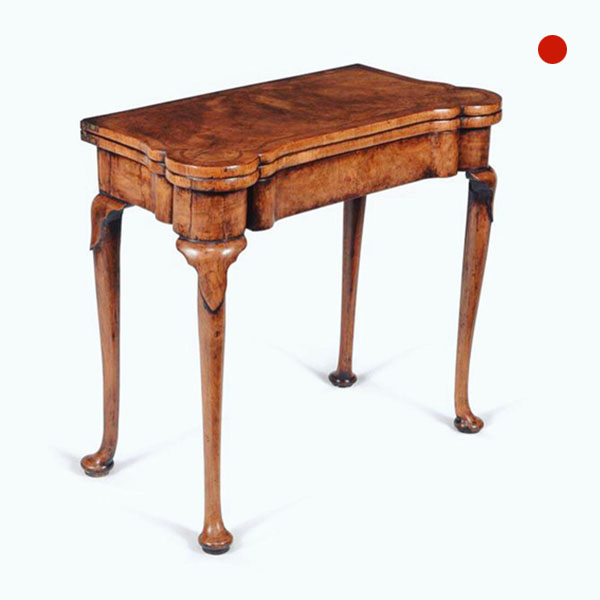
Fine 18th Century Queen Anne Burr and Highly Figured Walnut Card Table
Fine 18th Century Queen Anne Burr and Highly Figured Walnut Card Table SoldFollow UsFine 18th Century Queen Anne Burr and Highly Figured Walnut Card Table A fine and rare Queen Anne burr and highly figured walnut card table, circa 1710...
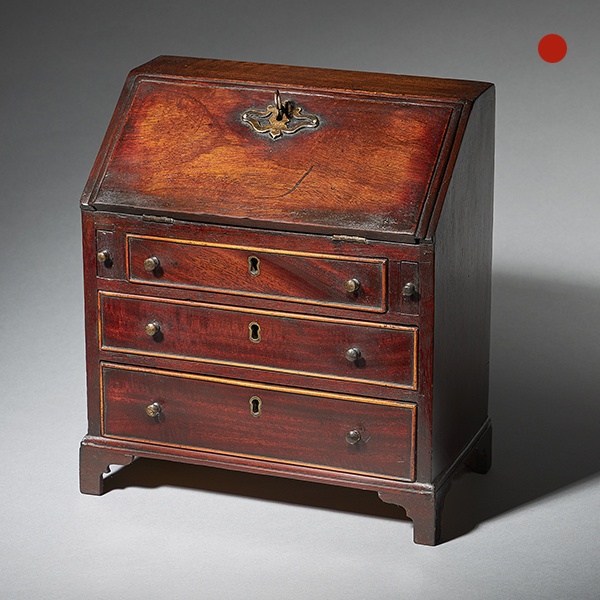
18th Century George II Mahogany Miniature Bureau
18th Century George II Mahogany Miniature Bureau SOLD Follow Us18th Century George II Mahogany Miniature Bureau What came first.... the miniature or the full scale? This small scale model at just 9” wide dates from the very beginning of the...

A superb 17th-century olive oyster lace box from the reign of King Charles II, circa 1675-85.
A superb 17th century olive oyster lace box from the reign of King Charles II, circa 1675-85. Geometric patterns adorn the selected and book-matched hand cut olive oysters to the top which is beautifully inlaid with fine boxwood stringing, cross-banded and edged with cross grain mouldings, all in figured olive.

17th-Century miniature table cabinet
The miniature table cabinet opens to an arrangement of drawers, a row of four, a bank of four and a long pen drawer, similarly veneered in oysters of olive.

A Delightful Mid 18th Century Irish Mahogany Console Table of Small Proportions (29”) Circa 1750-1760.
A Rare Mid 18th-Century Irish Mahogany Console Table of Small Proportions (29”)
With Moulded Edged Calacatta Rosati Marble.

Late 17th Century Charles II Carved Oak Bible Box, Deed Box, Blanket Box,or Candle Box
Late 17th Century Charles II Carved Oak Bible Bo, Deed, Blanket, or Candle Box Sold Follow UsLate 17th Century Charles II Carved Oak Bible, Deed, Blanket, or Candle Box A superb and original late 17th century oak box with excellent and deep...

Fine 18th Century Queen Anne Burr and Highly Figured Walnut Card Table
Fine 18th Century Queen Anne Burr and Highly Figured Walnut Card Table SoldFollow UsFine 18th Century Queen Anne Burr and Highly Figured Walnut Card Table A fine and rare Queen Anne burr and highly figured walnut card table, circa 1710...

18th Century George II Mahogany Miniature Bureau
18th Century George II Mahogany Miniature Bureau SOLD Follow Us18th Century George II Mahogany Miniature Bureau What came first.... the miniature or the full scale? This small scale model at just 9” wide dates from the very beginning of the...

A superb 17th-century olive oyster lace box from the reign of King Charles II, circa 1675-85.
A superb 17th century olive oyster lace box from the reign of King Charles II, circa 1675-85. Geometric patterns adorn the selected and book-matched hand cut olive oysters to the top which is beautifully inlaid with fine boxwood stringing, cross-banded and edged with cross grain mouldings, all in figured olive.

17th-Century miniature table cabinet
The miniature table cabinet opens to an arrangement of drawers, a row of four, a bank of four and a long pen drawer, similarly veneered in oysters of olive.

A Delightful Mid 18th Century Irish Mahogany Console Table of Small Proportions (29”) Circa 1750-1760.
A Rare Mid 18th-Century Irish Mahogany Console Table of Small Proportions (29”)
With Moulded Edged Calacatta Rosati Marble.
YOU MAY ALSO LIKE

A Fine William and Mary 17th Century Figured Walnut Cushion Mirror C, 1690
A Fine William and Mary 17th Century Figured Walnut Cushion Mirror C, 1690 £6,500Follow UsA Fine William and Mary 17th Century Figured Walnut Cushion Mirror C, 1690 A large William and Mary 17th century figured walnut cushion mirror, circa...
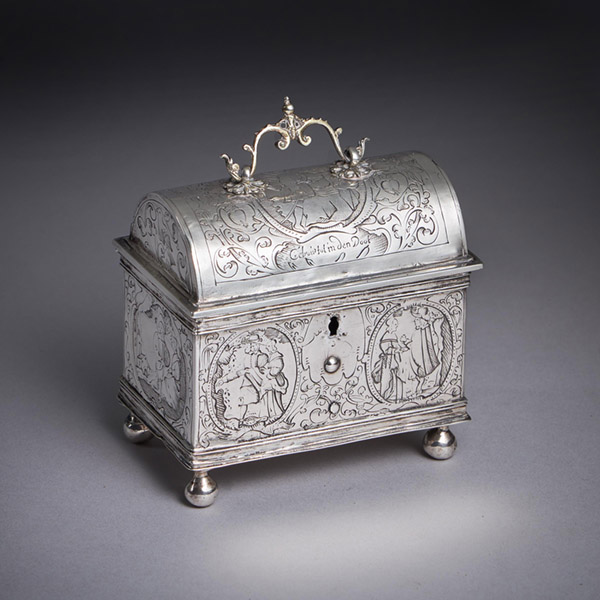
A museum-grade mid-17th century Dutch silver marriage casket or knottekistje, circa 1660
A museum-grade mid-17th century Dutch silver marriage casket or knottekistje, circa 1660 £9,500 [wpforms_selector form_id="11387" show_title="on" _builder_version="4.22.1" _module_preset="default" custom_margin="-30px||||false|false"...

19th-Century French Flame Mahogany Napoleon Empire Period Mantel Clock
19th-Century French Flame Mahogany Napoleon Empire Period Mantel Clock £6,800 [wpforms_selector form_id="11387" show_title="on" _builder_version="4.22.1" _module_preset="default" custom_margin="-30px||||false|false" global_colors_info="{}"...
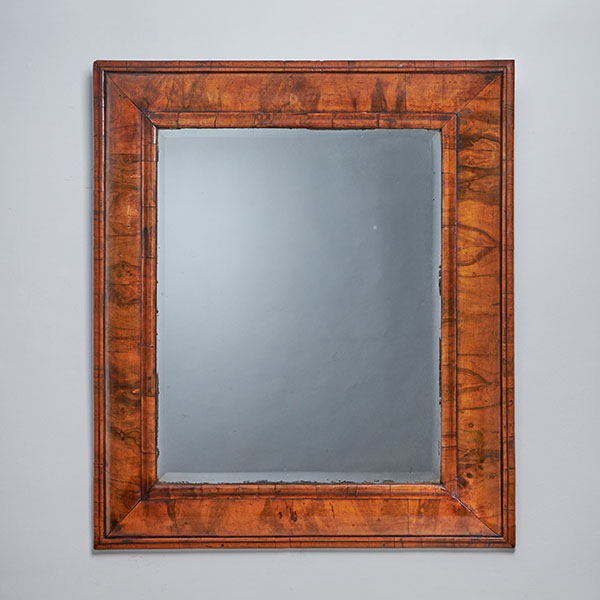
Large William and Mary 17th Century Figured Walnut Cushion Mirror c, 1690
Large William and Mary 17th Century Figured Walnut Cushion Mirror c, 1690 £7,495[wpforms_selector form_id="11387" show_title="on" _builder_version="4.22.1" _module_preset="default" custom_margin="-30px||||false|false" global_colors_info="{}"...

Pair of 18th Century George III Silver Candlesticks by David Bell, London, 1762
Pair of 18th Century George III Silver Candlesticks by David Bell, London, 1762 £5,995[wpforms_selector form_id="11387" show_title="on" _builder_version="4.22.1" _module_preset="default" custom_margin="-30px||||false|false"...
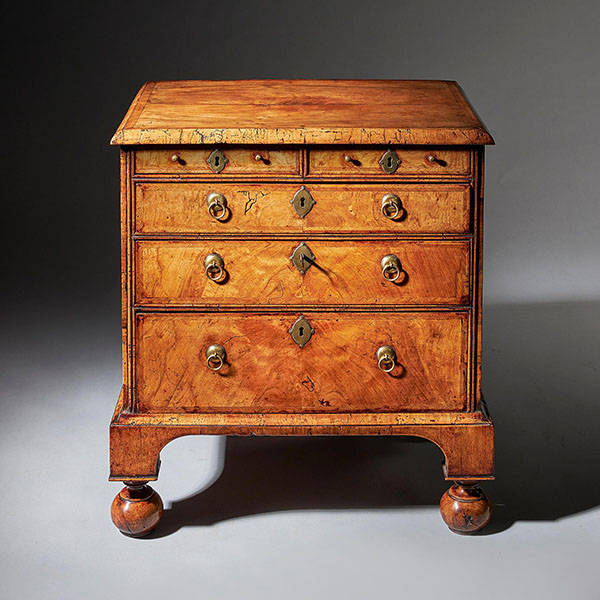
An extremely rare George I walnut chest of small proportions on ball and bracket
An extremely rare George I walnut chest of small proportions on ball and bracket £18,800[wpforms_selector form_id="11387" show_title="on" _builder_version="4.22.1" _module_preset="default" custom_margin="-30px||||false|false"...

A Fine William and Mary 17th Century Figured Walnut Cushion Mirror C, 1690
A Fine William and Mary 17th Century Figured Walnut Cushion Mirror C, 1690 £6,500Follow UsA Fine William and Mary 17th Century Figured Walnut Cushion Mirror C, 1690 A large William and Mary 17th century figured walnut cushion mirror, circa...

A museum-grade mid-17th century Dutch silver marriage casket or knottekistje, circa 1660
A museum-grade mid-17th century Dutch silver marriage casket or knottekistje, circa 1660 £9,500 [wpforms_selector form_id="11387" show_title="on" _builder_version="4.22.1" _module_preset="default" custom_margin="-30px||||false|false"...

19th-Century French Flame Mahogany Napoleon Empire Period Mantel Clock
19th-Century French Flame Mahogany Napoleon Empire Period Mantel Clock £6,800 [wpforms_selector form_id="11387" show_title="on" _builder_version="4.22.1" _module_preset="default" custom_margin="-30px||||false|false" global_colors_info="{}"...

Large William and Mary 17th Century Figured Walnut Cushion Mirror c, 1690
Large William and Mary 17th Century Figured Walnut Cushion Mirror c, 1690 £7,495[wpforms_selector form_id="11387" show_title="on" _builder_version="4.22.1" _module_preset="default" custom_margin="-30px||||false|false" global_colors_info="{}"...

Pair of 18th Century George III Silver Candlesticks by David Bell, London, 1762
Pair of 18th Century George III Silver Candlesticks by David Bell, London, 1762 £5,995[wpforms_selector form_id="11387" show_title="on" _builder_version="4.22.1" _module_preset="default" custom_margin="-30px||||false|false"...

An extremely rare George I walnut chest of small proportions on ball and bracket
An extremely rare George I walnut chest of small proportions on ball and bracket £18,800[wpforms_selector form_id="11387" show_title="on" _builder_version="4.22.1" _module_preset="default" custom_margin="-30px||||false|false"...






